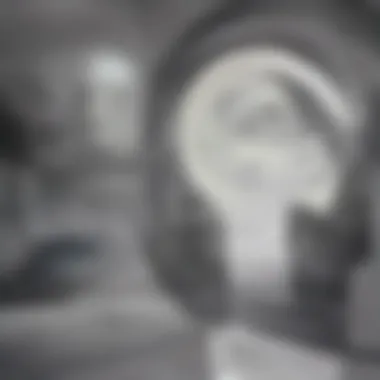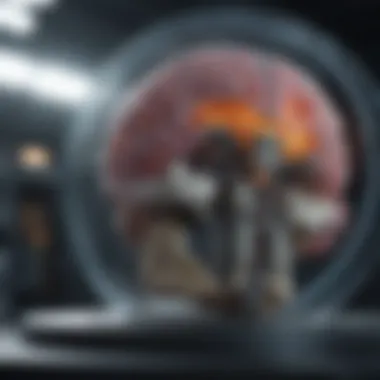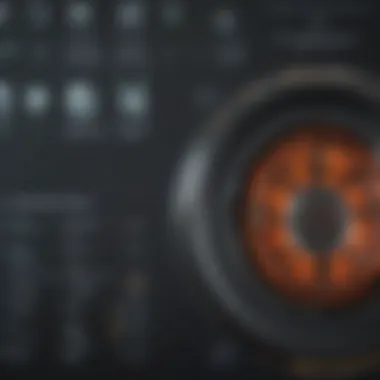Understanding MRI and MRCP: Advanced Imaging Insights


Intro
Magnetic Resonance Imaging (MRI) and Magnetic Resonance Cholangiopancreatography (MRCP) represent pivotal advancements in the field of medical imaging. These modalities empower healthcare professionals with non-invasive methods to assess soft tissues and organ systems, enabling accurate diagnosis and treatment planning. In this article, we will explore these technologies, examining their principles, applications, and significance in patient care.
Background and Context
Overview of the Research Topic
MRI is a technique utilized primarily to visualize internal body structures, particularly the brain, spine, joints, and soft tissues. Utilizing strong magnetic fields and radio waves, it creates detailed images, allowing for enhanced diagnosis of various conditions. In contrast, MRCP is a specialized form of MRI specifically aimed at obtaining images of the biliary and pancreatic ducts. This technique is particularly beneficial in evaluating obstructive jaundice, pancreatitis, and other disorders of the gastrointestinal system.
Historical Significance
The roots of MRI date back to the 1970s, when it emerged as a groundbreaking alternative to X-rays and CT scans. Raymond Damadian's work laid the groundwork for this technology, leading to its clinical use in the early 1980s. MRCP, however, is a more recent development, gaining popularity in the late 1990s due to its ability to non-invasively visualize biliary structures without the need for contrast agents.
MRI and MRCP have revolutionized the field of diagnostics, significantly impacting patient outcomes by allowing for earlier detection and improved treatment efficacy.
Key Findings and Discussion
Major Results of the Study
Recent studies highlight that both MRI and MRCP are instrumental in the diagnosis of numerous medical conditions. MRI is particularly adept at revealing tumors, neurological disorders, and soft tissue injuries. Meanwhile, MRCP excels at assessing biliary obstructions and identifying stones or strictures in the biliary tree.
Detailed Analysis of Findings
Research indicates that the sensitivity of MRI in detecting certain tumors can be higher than that of other imaging modalities. For instance, in neurological applications, its ability to differentiate between healthy and pathological tissues is unparalleled. Meanwhile, MRCP has been proven to be highly effective in detecting diseases of the pancreas, such as choledocholithiasis.
In both cases, these imaging techniques provide essential information that can guide therapeutic decisions and enhance surgical planning.
Ending
As we delve further into the complexities of MRI and MRCP in subsequent sections, we aim to provide a comprehensive understanding of their roles, operational mechanics, and clinical relevance. The ongoing advancements in these imaging technologies promise to further enhance their capabilities and, consequently, patient care.
Overview of MRI
Magnetic Resonance Imaging (MRI) has emerged as a cornerstone in medical diagnostics. This section covers its fundamental significance. MRI allows for non-invasive visualization of internal structures, enhancing the ability to diagnose various conditions accurately. Its utilization spans numerous medical fields, reaffirming its integral role in patient care. The advantages of MRI include its ability to produce high-resolution images without using ionizing radiation, making it a preferred choice for imaging soft tissues.
History of MRI Technology
MRI technology evolved through the late 20th century following foundational discoveries in nuclear magnetic resonance. The development of the first functional MRI scanner in the 1970s by Dr. Raymond Damadian revolutionized imaging techniques. Initially, MRI focused on examining soft tissues, with subsequent improvements in the quality of images leading to its widespread clinical application. Over decades, technological advancements have rendered MRI an indispensable tool in medicine, consistently refining the imaging process.
Principles of Magnetic Resonance Imaging
Basic Physics Involved
The basic physics behind MRI relies on principles involving nuclear magnetic resonance. When placed in a magnetic field, certain atomic nuclei resonate at specific frequencies. This phenomenon enables imaging of internal structures. The key characteristic of this principle is its non-invasive nature, allowing physicians to view organs and tissues without surgery. One unique feature is the ability to differentiate between various types of tissue based on their magnetic properties, thereby increasing the utility of MRI in diagnosing conditions.
Electromagnetic Fields and Resonance
Electromagnetic fields play a crucial role in MRI imaging. The interaction between these fields and the hydrogen nuclei in the body offers detailed visuals. A significant characteristic of these fields is their ability to manipulate the position of spins within the nuclei. In terms of benefits, this approach enhances the clarity of the images. However, electromagnetic interference can sometimes complicate the imaging process, necessitating careful operation.
Components of MRI Systems
The Magnet
At the heart of an MRI system is the magnet, which creates the strong magnetic field needed for imaging. The primary characteristic of the magnet is its strength, typically measured in teslas. A high-strength magnet allows for clearer and more detailed images. One unique feature of modern MRI magnets is their superconducting capability, which enhances efficiency but comes with a high initial cost.


Radiofrequency Coils
Radiofrequency coils are essential components that transmit and receive signals based on the emitted energy from excited hydrogen nuclei. The distinctive aspect is their specific design that targets particular body parts, increasing the efficiency of imaging. Radiofrequency coils markedly improve the signal-to-noise ratio of the images, but they require careful calibration to function effectively across different applications.
Gradient Coils
Gradient coils are responsible for spatial encoding of the MRI signals, allowing for precise localization of the signals within the scanned area. Their key characteristic is their role in altering the magnetic field to create slices of images. This capability enhances the imaging resolution significantly. However, gradient coils can produce additional noise and require intricate engineering to minimize this drawback without compromising the quality of the images.
Applications of MRI in Medicine
Magnetic Resonance Imaging has revolutionized the way we view the human body, offering clinicians a non-invasive method for diagnosing and monitoring a wide range of medical conditions. The applications of MRI are diverse, impacting multiple fields such as neurology, musculoskeletal medicine, and cardiology. This section explores the key ways MRI is utilized in medicine, highlighting its benefits and considerations.
Neurological Imaging
Detecting Brain Tumors
Detecting brain tumors with MRI plays a critical role in modern diagnostics. The most significant aspect is the ability of MRI to offer high-resolution images of the brain without exposing patients to ionizing radiation. This characteristic makes MRI particularly useful because early detection can drastically improve prognosis. MRI employs contrast agents, such as gadolinium, to enhance the visibility of tumors, thus allowing for detailed assessment of their size and location. However, it's essential to note that specific MRI protocols must be followed to optimize image quality.
MRI has become the gold standard for brain tumor detection due to its superior soft tissue contrast.
Assessing Multiple Sclerosis
In assessing multiple sclerosis, MRI has proven invaluable. The technique identifies lesions and plaques that signify disease activity. A key characteristic of using MRI in this context is its sensitivity to changes in brain morphology over time. Therefore, periodic MRI scans are beneficial to monitor disease progression and treatment response. Unique to this application, MRI can visualize both acute and chronic lesions, aiding in more accurate diagnosis. However, practitioners must be cautious in interpreting results, as certain artifacts could mimic pathological changes.
Musculoskeletal Imaging
Evaluating Joint Conditions
MRI plays a prominent role in evaluating joint conditions, particularly in diagnosing injuries and degenerative diseases. This imaging method excels because it provides detailed visualization of soft tissues, including cartilage and ligaments. A key characteristic is that MRI can assess the extent of damage in various conditions, like rheumatoid arthritis or meniscal tears. Its ability to differentiate normal and abnormal tissues offers substantial benefits for treatment planning, though certain limitations exist, such as patient movement during scans affecting image quality.
Identifying Soft Tissue Injuries
Identifying soft tissue injuries is another significant application of MRI. This aspect focuses on accurately detecting tears and strains in muscles and tendons, which can be challenging with other imaging modalities. The unique feature of MRI lies in its capability to visualize the entire musculoskeletal system in various planes, allowing for comprehensive assessments. While MRI is highly effective, considerations must be made regarding the cost and availability of the technology in some regions.
Cardiac MRI
Characterizing Cardiomyopathies
Cardiac MRI is integral in characterizing cardiomyopathies. Its detailed images help clinicians understand the heart's structure and function. A pivotal aspect is its use of late gadolinium enhancement techniques that can identify fibrosis within the heart muscle, a crucial factor in determining treatment options. This application benefits from MRI’s capacity to evaluate cardiac motion and perfusion, contributing to a well-rounded assessment, although the complexity of interpreting cardiac images requires dedicated expertise.
Evaluating Myocardial Ischemia
When it comes to evaluating myocardial ischemia, MRI provides differentiating power through its ability to measure myocardial perfusion and viability. The key characteristic here is the non-invasive assessment of blood flow, allowing physicians to make informed decisions regarding interventions. While MRI demonstrates significant strengths, limitations such as patient claustrophobia and the need for specialized equipment are worth mentioning.
In summary, MRI serves vital roles across various applications in medicine, providing intricate insights that guide diagnosis and treatment plans. Its capacity for high-resolution imaging, without ionizing radiation, demonstrates its importance in clinical practice.
Understanding MRCP
Understanding MRCP is vital in the broader context of this article. MRCP, or Magnetic Resonance Cholangiopancreatography, represents a specialized application of MRI technology, primarily focused on visualizing the biliary and pancreatic ducts. This focus not only highlights the technique's unique contribution to medical imaging but also emphasizes its benefits in clinical scenarios where non-invasive diagnostics can significantly alter patient outcomes.
By dissecting MRCP’s principles, differences from standard MRI, and its clinical utility, readers can appreciate how this technique enhances diagnostic accuracy and improves management of specific gastrointestinal conditions. Moreover, exploring MRCP's applications informs healthcare professionals about its importance in patient care, guiding them towards better decision-making.
What is MRCP?
MRCP is a non-invasive imaging technique used to visualize the bile ducts, pancreatic duct, and surrounding structures. Unlike traditional MRI scans that focus on soft tissues generally, MRCP specifically targets the ducts, providing detailed images without the need for invasive procedures.


One of its defining characteristics is the ability to obtain high-quality images through the use of specific pulse sequences that enhance fluid signals. This quality makes MRCP an excellent choice for evaluating conditions like cholestasis or stones in the bile ducts.
Differences Between MRI and MRCP
Specificity and Purpose
The specificity of MRCP lies in its unique capability to highlight the biliary and pancreatic systems. Regular MRI scans offer broad imaging options but lack the specialization that MRCP provides. With MRCP, clinicians can more effectively diagnose issues like biliary obstruction or pancreatitis. The focused nature of MRCP ensures that it can deliver clearer and more relevant information regarding these particular areas. This heightened specificity increases its practical utility in clinical settings, making it a preferred choice for certain diagnostic scenarios.
Imaging Techniques Employed
MRCP utilizes advanced imaging techniques that differ from those used in standard MRI scans. Techniques like Short Tau Inversion Recovery (STIR) and specific fat suppression methods are essential to visualize the ducts without surrounding tissues obscuring the view. These imaging techniques enhance the overall effectiveness of MRCP in providing precise diagnositcs. Due to their focused nature, these methods allow MRCP to be a powerful diagnostic tool while minimizing patient discomfort and recovering time.
Clinical Utility of MRCP
Diagnosing Biliary Obstruction
In the realm of diagnosing biliary obstruction, MRCP proves to be indispensable. It provides clear visual representation of bile duct anatomy and any obstructions present, making it easier for clinicians to assess the underlying causes of jaundice or abdominal pain. Its non-invasive nature means that it can be repeated if needed, allowing for ongoing monitoring. Additionally, MRCP avoids the risks associated with invasive procedures such as ERCP. This feature significantly benefits patients, reducing the need for multiple invasive diagnostic tests.
Evaluating Pancreatic Disease
Evaluating pancreatic disease is another crucial aspect of MRCP. The technique's ability to provide high-resolution images of the pancreatic duct can play a key role in diagnosing conditions like chronic pancreatitis or pancreatic cancer. With MRCP, clinicians can identify structural anomalies and interpret their clinical significance without resorting to surgical intervention. This ability makes MRCP a non-invasive approach that aligns well with current trends in patient-centered care.
Technology Behind MRCP
The technology underlying Magnetic Resonance Cholangiopancreatography is integral to its success in clinical imaging. MRCP stands out in the realm of imaging techniques, particularly due to its non-invasive nature and its ability to visualize biliary and pancreatic ducts with impressive clarity. Understanding the technology enhances the comprehension of MRCP's application in various medical scenarios, especially in diagnosing conditions affecting the biliary tract and pancreas.
Sequence Techniques in MRCP
Short Tau Inversion Recovery (STIR)
The Short Tau Inversion Recovery technique is crucial in MRCP as it helps in suppressing fat signals. This is especially helpful for identifying fluid-filled structures, which is a primary goal in cholangiopancreatography. The key characteristic of STIR is its effectiveness in distinguishing between fat and fluid, making it a favored choice in many imaging protocols.
One unique feature of STIR is its selective suppression of fat signals while retaining the visibility of other tissues. This contributes significantly to the clarity of the images produced. However, STIR can lead to longer scan times, which may be seen as a disadvantage in high-throughput settings.
Fat Suppression Techniques
Fat Suppression Techniques play a fundamental role in MRCP imaging. These techniques are designed to minimize the signal from fat, which can obscure the visualization of target structures, such as biliary and pancreatic ducts. The key characteristic of these techniques is their capacity to enhance the contrast of the images, allowing clinicians to focus on the relevant anatomical details without interference from surrounding fat tissue.
One unique feature of Fat Suppression Techniques is their ability to provide clear images in less time compared to other methods. This not only improves the workflow in clinical settings but also enhances patient experience by reducing scan duration. However, there can be trade-offs, such as potential artifacts if parameters are not optimally set.
Optimization of MRCP Imaging
Optimizing MRCP imaging involves adjusting several parameters to improve the quality of images while ensuring patient comfort. Factors such as magnetic field strength, timing of sequences, and patient positioning need careful consideration. For instance, using higher field strengths can lead to better image resolution. However, it also increases the risk of peripheral nerve stimulation in patients.
MRI and MRCP in Clinical Practice
MRI and MRCP play crucial roles in modern medical diagnostics. Their integration into clinical practice has enhanced the ability to diagnose and monitor a wide range of diseases. These imaging techniques provide high-resolution images of soft tissues and organs, enabling health professionals to make informed decisions regarding patient care. The understanding of how to use MRI and MRCP effectively is essential for improving patient outcomes.
Patient Preparation for MRI and MRCP
Assessment of Contraindications
The assessment of contraindications is a pivotal component when preparing patients for MRI and MRCP. It ensures that patients do not undergo procedures where there could be health risks. For instance, patients with certain implanted devices, such as pacemakers or metal fragments, may face significant risks during an MRI due to the strong magnetic fields.
Key characteristics of this assessment include comprehensive medical history and physical examination of patients. This approach makes it a beneficial choice for ensuring safety in clinical practice. A unique feature of assessing contraindications is that it allows clinicians to tailor their imaging strategy. This assessment's main advantage is patient safety, whereas a disadvantage might be that some patients become anxious about their situation.
Instructions for Patients


Providing clear instructions for patients is fundamental in ensuring the success of MRI and MRCP. Proper guidance helps prepare patients physically and mentally for the imaging process. Key characteristics include detailed explanations about what to expect during the procedure, such as noise from the machine and the duration of the scan.
This aspect is popular because it enhances patient cooperation and reduces anxiety, making imaging more efficient. A unique feature of patient instructions is their ability to clarify pre-procedure protocols, like fasting or avoiding specific medications. The advantage here lies in improved imaging quality, while the disadvantage could be the need for additional time in patient education.
Interpreting MRI and MRCP Images
Key Features to Look For
Key features to look for when interpreting MRI and MRCP images are essential for effective diagnosis. Radiologists focus on identifying abnormalities such as tumors, lesions, and structural deformities. Detailed attention to these features contributes significantly to achieving accurate diagnoses.
The prominence of this aspect is beneficial due to its direct impact on patient management plans. A unique characteristic involves recognizing patterns specific to particular diseases, which enhances clinical decision-making. The advantage of this approach is improved diagnostic accuracy, while a disadvantage might include the potential for misinterpretation if features are subtle.
Common Pitfalls in Interpretation
Common pitfalls in interpretation can hinder accurate diagnoses and patient care. Radiologists often encounter challenges such as overlapping anatomical structures or artifacts that mimic pathologies. Understanding these pitfalls is crucial for accurate imaging results.
This knowledge is beneficial as it raises awareness amongst healthcare professionals about the limitations of imaging techniques. A unique aspect is the emphasis on continuous training and education to minimize errors. While this contributes to better patient outcomes, the disadvantage may involve additional time spent in training sessions that could be challenging within busy clinical settings.
Understanding and addressing these factors improve the efficacy of MRI and MRCP in clinical practice, leading to enhanced diagnostic precision and patient safety.
Overall, the integration of MRI and MRCP into clinical practice necessitates a commitment to patient preparation, effective image interpretation, and continuous learning.
Future Directions in MRI and MRCP Technology
The advancement of medical imaging technology is crucial in enhancing diagnostic accuracy and improving patient care. This section discusses the future directions in MRI and MRCP technology. It emphasizes specific elements that hold great promise, such as innovations in imaging techniques and the integration of artificial intelligence. The benefits of these advancements should be clearly understood by students, researchers, and professionals in the medical field.
Advancements in Imaging Techniques
Innovations in imaging techniques aim to enhance the detail and speed of MRI and MRCP examinations. This may include higher-resolution imaging and faster acquisition times. New sequences of imaging may allow us to visualize anatomical structures and physiological processes more clearly. For example, diffusion-weighted imaging provides insight into tissue integrity, which is useful in assessing conditions like stroke.
These advancements can lead to quicker diagnoses, ultimately resulting in better patient outcomes. Multi-parametric MRI is also becoming more common, combining various imaging techniques in one scan. Such multifaceted approach helps in providing a more comprehensive picture of the patient's condition.
Integration of Artificial Intelligence in Imaging
The application of artificial intelligence in imaging is a significant direction for the future. AI algorithms can analyze images quickly, highlighting anomalies that may be overlooked by even experienced radiologists. This is particularly beneficial in busy clinical environments where time is of the essence.
AI in Image Analysis
AI in image analysis focuses on automating the examination process. This not only helps in improving efficiency but also ensures more consistent results. A key characteristic is its ability to learn from large data sets, allowing it to improve over time. The unique feature of AI is its computational power, which can process complex patterns in MRI and MRCP images effectively. However, there are concerns about over-reliance on technology and the need for human oversight in interpretations.
Predictive Analytics in Patient Management
Predictive analytics in patient management utilizes data from previous cases to forecast outcomes. This technique is growing in importance as it helps healthcare professionals make informed decisions. A key characteristic of predictive analytics is its ability to aggregate and analyze vast amounts of data quickly. This capability is especially beneficial for identifying high-risk patients before complications arise. The challenge here remains in the effective integration of such technology into clinical practice, as well as ensuring reliability and accuracy in predictions.
The presence of AI in clinical imaging is transforming the way diagnoses are made and how patient management is approached, enabling more strategic treatment pathways.
In sum, the impressive advancements in imaging techniques and the integration of AI hold the potential to revolutionize MRI and MRCP. Those engaged in health care must keep abreast of these developments to maximize their benefits for patient care.
Epilogue
In this final section, it is essential to reflect on the significance of MRI and MRCP as advanced imaging techniques within the medical field. These modalities have transformed diagnostic capabilities, offering unparalleled insights into human anatomy and pathology. Understanding how MRI and MRCP operate is vital for healthcare professionals, as it informs clinical decision-making and enhances patient care.
Summary of Key Points
MRI and MRCP provide unique benefits. MRI excels in soft tissue contrast, which allows for detailed imaging of the brain, muscles, and joints. MRCP, on the other hand, focuses on the biliary and pancreatic systems, facilitating the diagnosis of various conditions. Key insights from this discussion include:
- Technological Foundations: MRI utilizes strong magnetic fields and radio waves, while MRCP employs specialized techniques to visualize the biliary tree.
- Clinical Applications: MRI is widely used for neurological and musculoskeletal disorders, whereas MRCP serves to diagnose obstructions and pancreatic diseases.
- Innovation and Future Directions: Advancements in imaging techniques and the integration of artificial intelligence are shaping the future of these modalities.
In summary, both MRI and MRCP hold significant roles in diagnostics, contributing to effective disease management and patient outcomes.
The Importance of Ongoing Research
Research is crucial in the realm of MRI and MRCP. Continuous advancements in technology and techniques can lead to improved image quality, reduced scan times, and enhanced patient safety. Areas of focus for ongoing research include:
- Image Acquisition: Developing faster and more efficient imaging protocols can benefit not only facility efficiency but also the patient experience.
- Contrast Agents: Investigating new contrast agents can enhance the visibility of specific features, thereby improving diagnostic accuracy.
- Artificial Intelligence: As AI continues to evolve, its deployment in image analysis and predictive diagnostics can lead to transformative changes in how conditions are detected and treated.
Ongoing research efforts exemplify the medical community's commitment to advancing MRI and MRCP technologies, ensuring they meet the needs of evolving healthcare environments.







